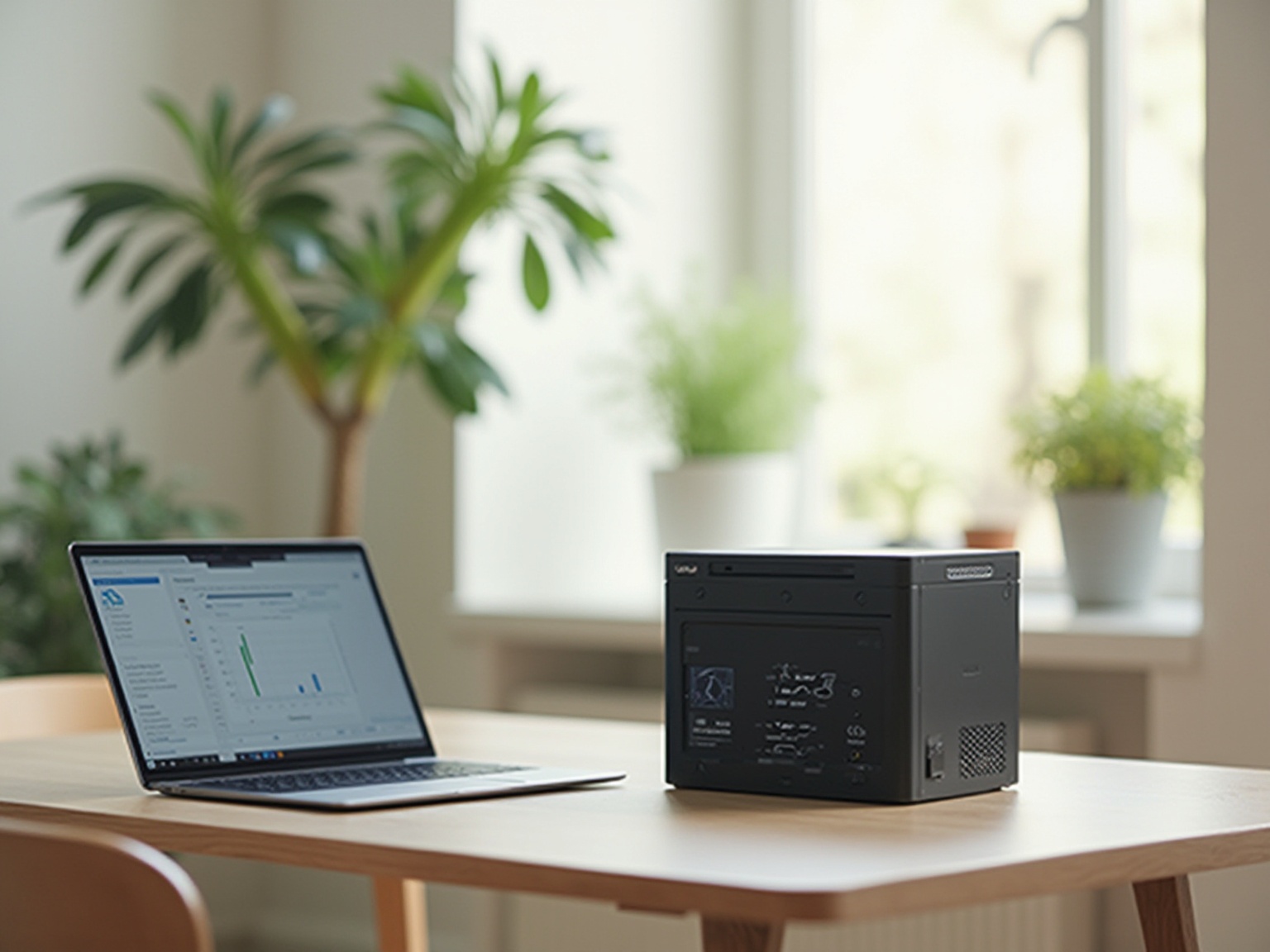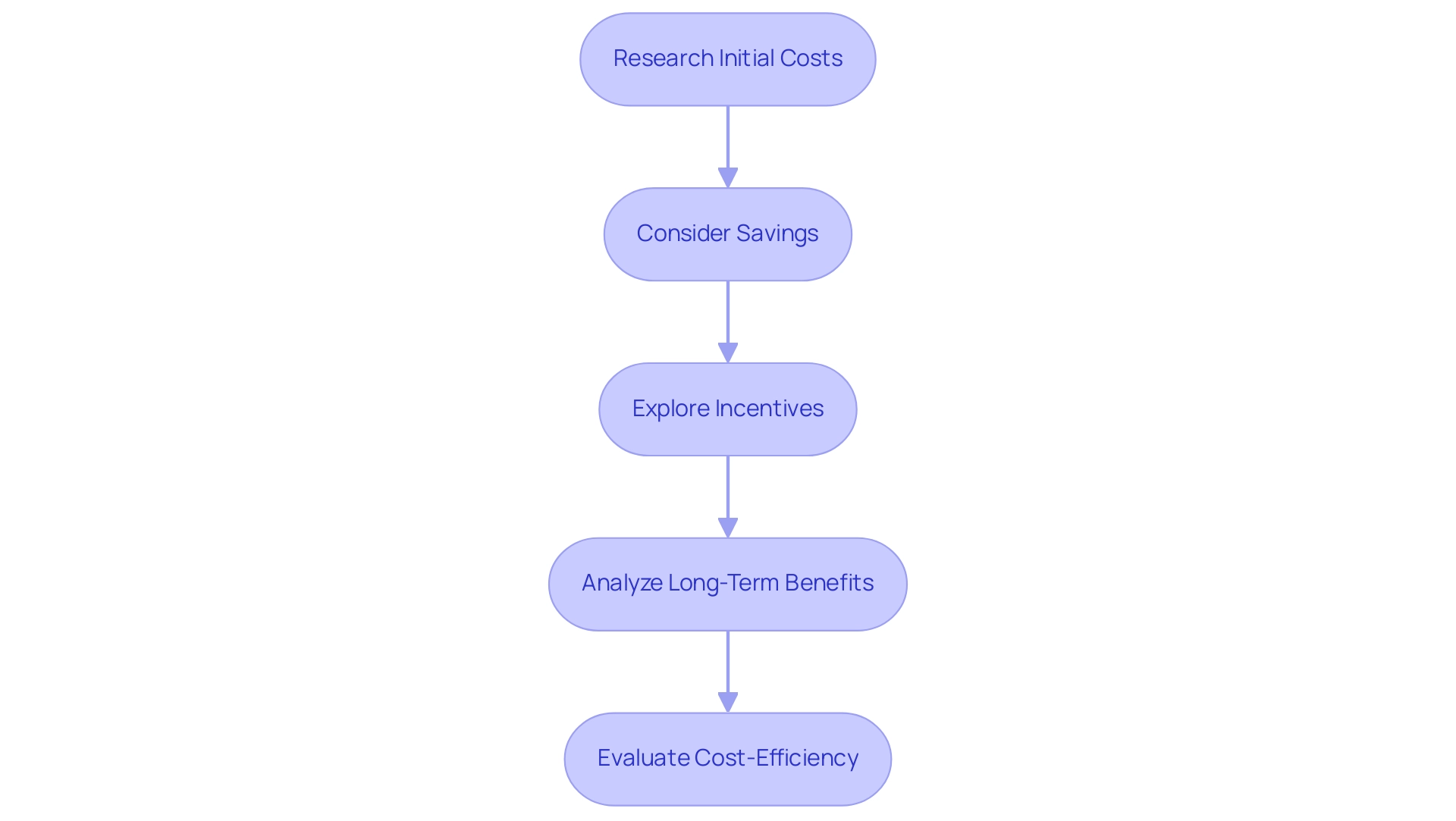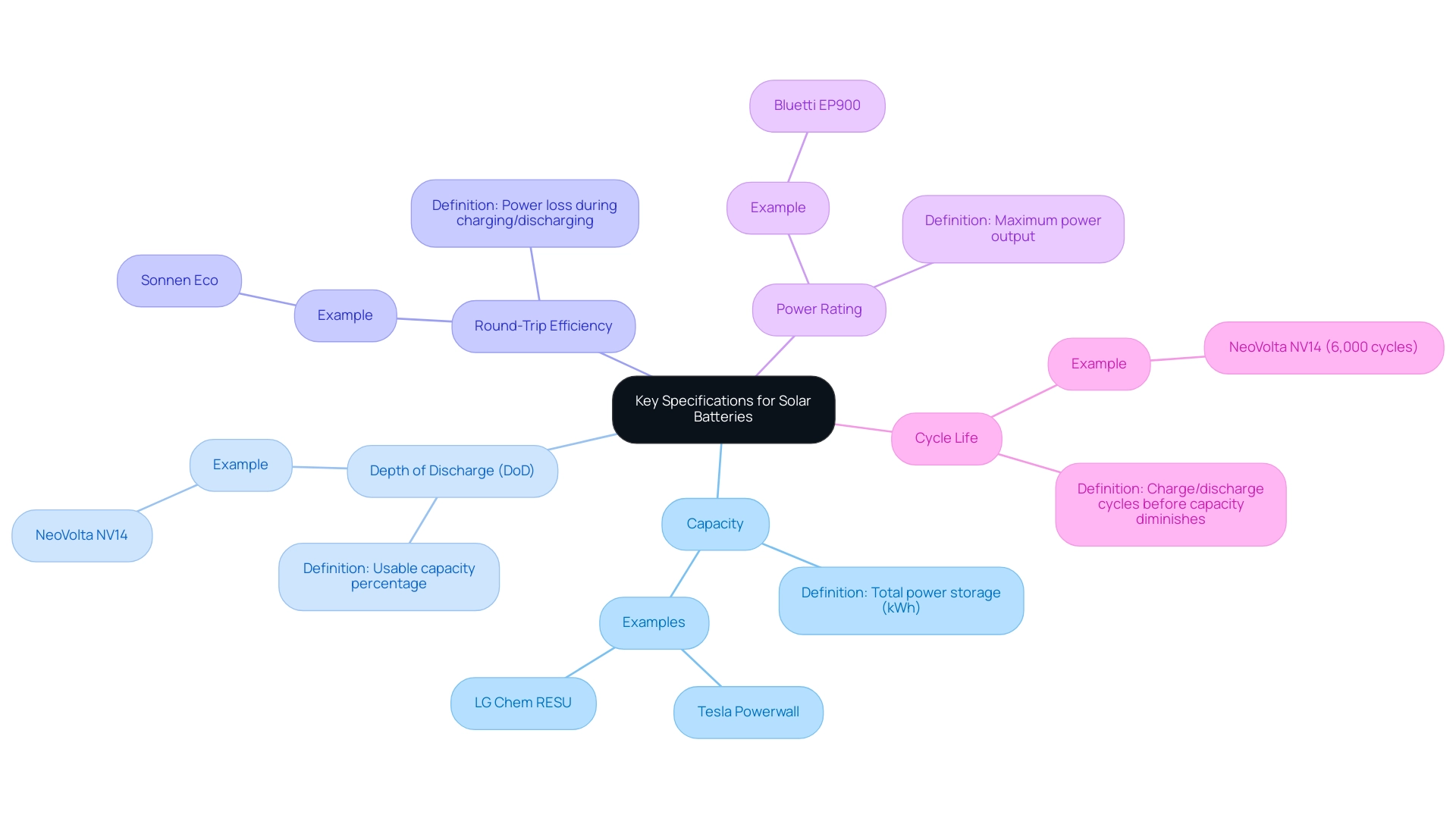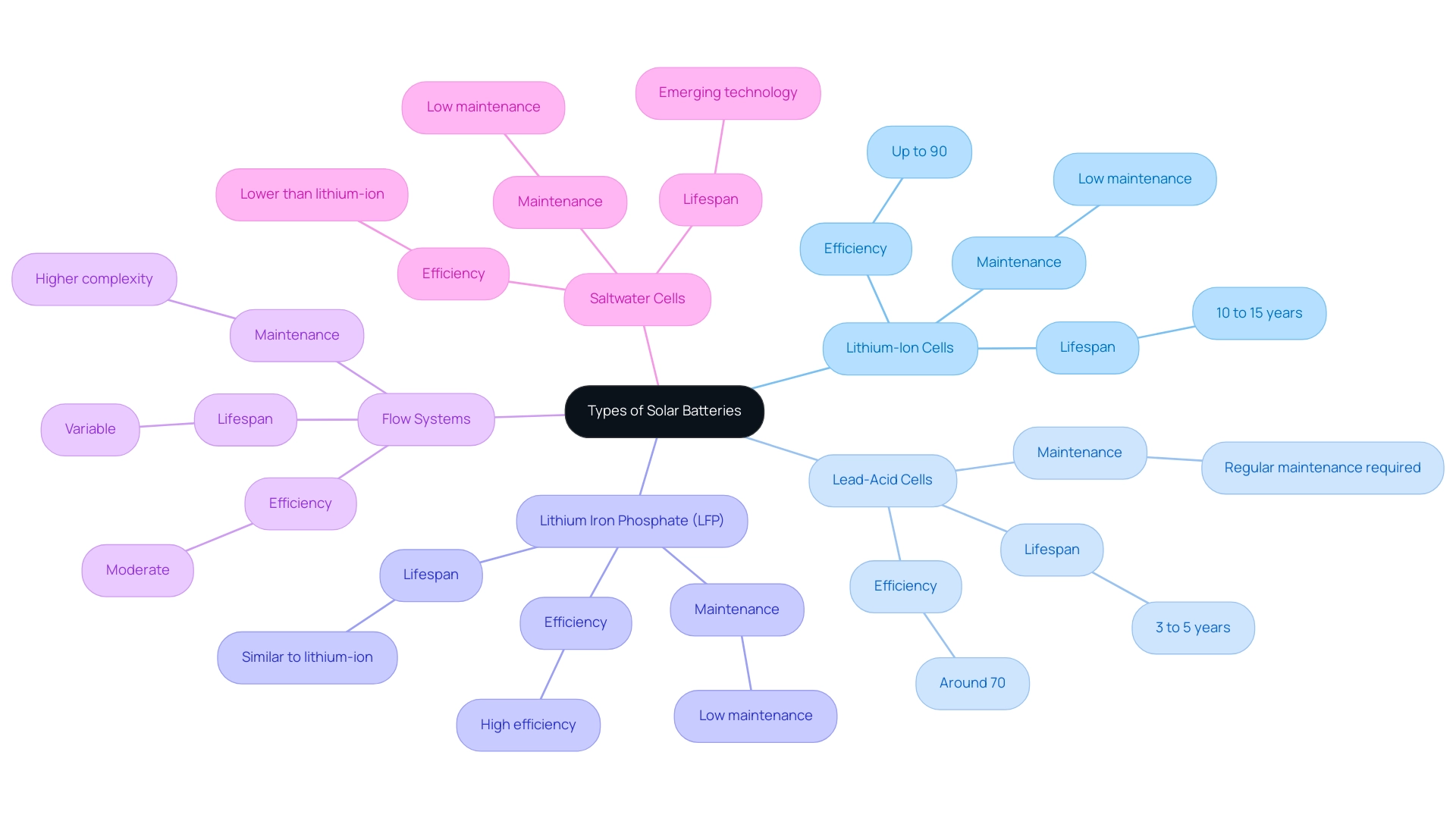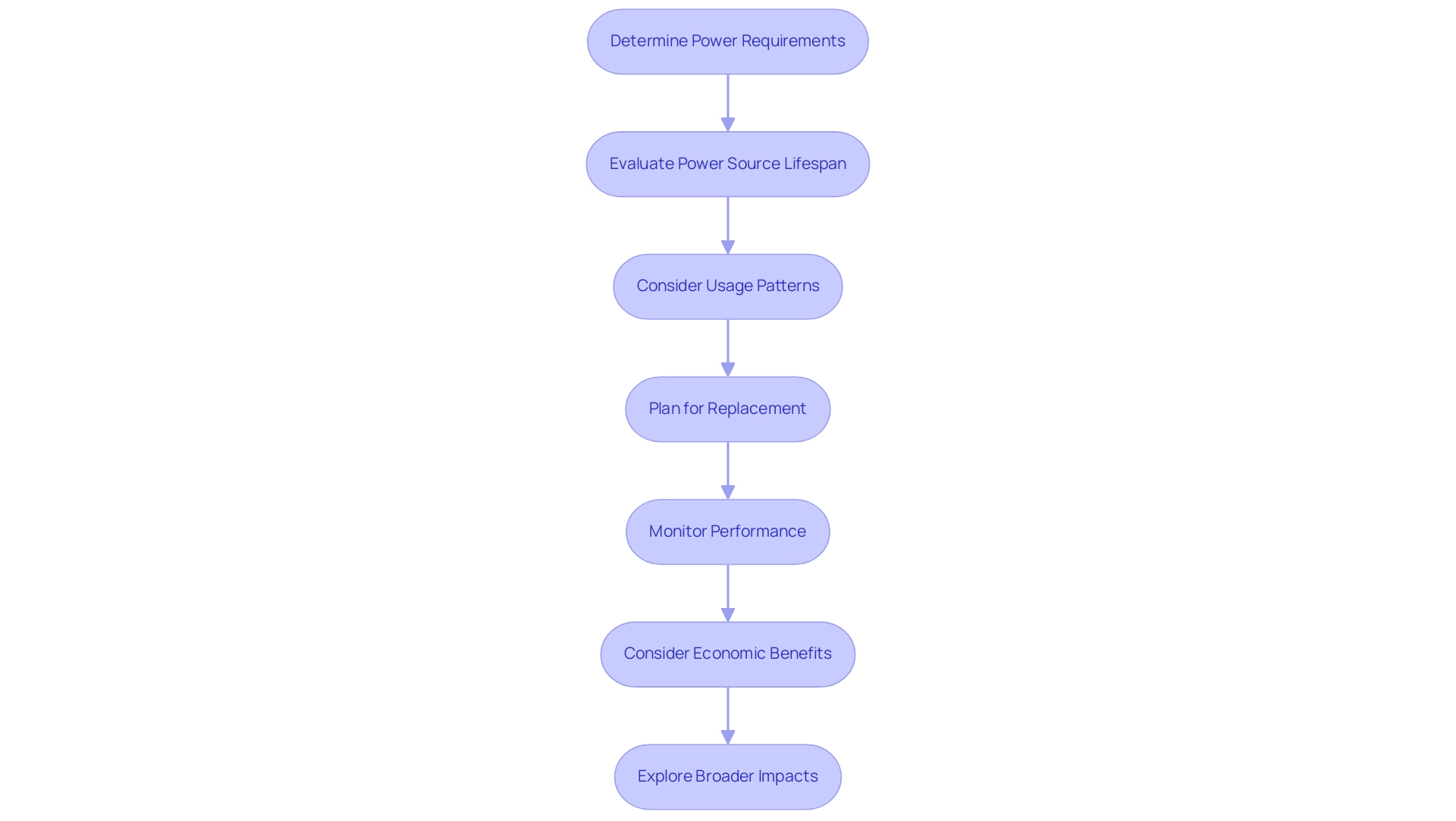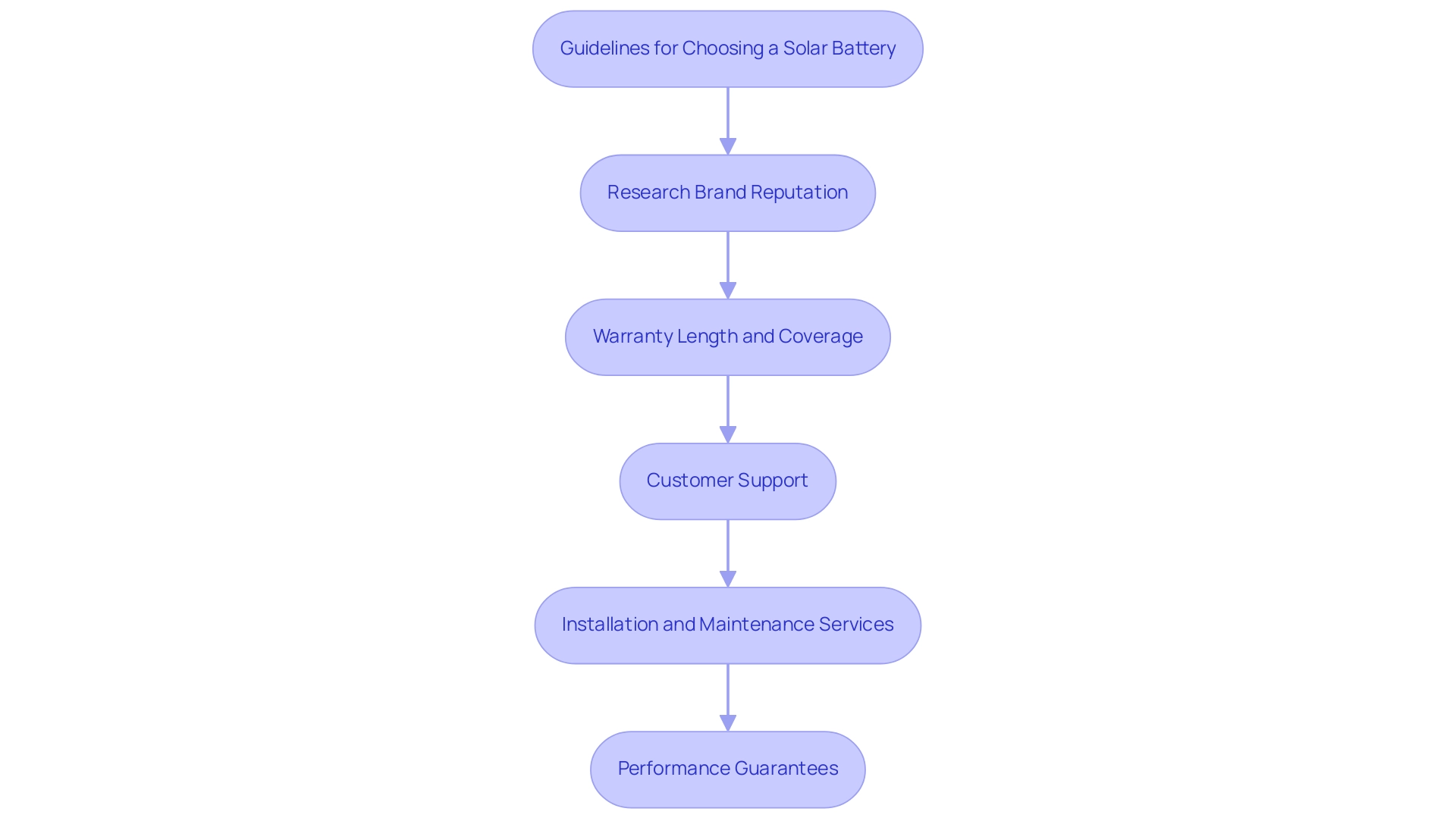Overview
We understand that many homeowners are concerned about rising energy bills and are seeking sustainable solutions. To choose the best battery for your solar system, it’s essential to consider key specifications such as:
- Capacity
- Depth of discharge
- Round-trip efficiency
- Power rating
- Cycle life
Additionally, evaluating initial costs, potential savings, and available incentives can significantly impact your decision-making process.
By understanding these factors and comparing different battery types, especially lithium-ion options, you can make informed decisions that align with your energy needs and financial goals. This knowledge empowers you to enhance your energy independence, allowing you to take control of your energy future.
Together, we can navigate this journey towards sustainability and energy efficiency. If you have questions or need support, please don’t hesitate to reach out. Your path to energy independence is just a conversation away.
Introduction
In the quest for sustainable energy solutions, we understand that many homeowners are concerned about rising energy costs and the impact on our environment. Solar batteries have emerged as a pivotal component for those looking to harness the power of the sun. It’s common to feel uncertain about the best options available, which is why understanding the cost-effectiveness, specifications, and types of solar batteries is essential for making informed decisions.
This comprehensive guide is here to support you in evaluating the financial implications of solar battery installations. Together, we will compare various options and explore the long-term benefits of integrating these systems into your residential energy solutions. With insights from industry experts and a focus on reliable brands, you can navigate the complexities of solar energy storage with confidence. By doing so, you not only enhance your energy independence but also contribute to a greener future for all of us. Let’s work towards a sustainable tomorrow, one solar battery at a time.
Evaluating the Cost-Effectiveness of Solar Batteries
To effectively evaluate the cost-effectiveness of solar batteries, it’s important to consider a few supportive steps:
- Research Initial Costs: Begin by gathering detailed information on the prices of various energy storage systems, including installation fees. In 2025, typical costs range from $9,000 to $19,000, influenced by the battery type and its capacity. Understanding these costs is crucial for homeowners like you who are looking to invest in effective power solutions, especially when considering the installation of a Tesla Level 2 home charger alongside the best battery for solar systems.
- Consider Savings: Think about how much you could save on your electricity bills by estimating the power you can store and utilize during peak hours. Online calculators or conversations with renewable power specialists can provide valuable insights tailored to your circumstances, helping you grasp the financial advantages of combining renewable sources with EV charging solutions.
- Explore Incentives: Investigate the federal and state incentives available to you, which can significantly reduce the initial expenses of renewable energy storage systems. Notably, the federal tax incentive for renewable sources currently covers 30% of installation expenses for systems, including storage units that can hold a minimum of 3kWh of capacity, installed in 2024 or afterward. This incentive is a key factor in enhancing the overall cost-effectiveness of your investment, making solar power more accessible for environmentally conscious property owners.
- Analyze Long-Term Benefits: Assess the lifespan of the energy source, which typically ranges from 5 to 15 years. This longevity is especially valuable for homeowners with critical power needs or those seeking independence, as it contributes to reliability during outages and enhances the overall value of your investment. Understanding these long-term advantages is essential when comparing renewable energy storage systems, such as the best battery for solar systems, with conventional electricity sources.
- Finally, evaluate the cost-efficiency of photovoltaic batteries against other power storage options or reliance on the grid to identify the best battery for solar systems. This comparison will help you make an informed decision that aligns with your resource needs and financial goals. Additionally, consider the various financing options available for installations, such as cash purchases, loans, and leases, as these can significantly impact the overall cost and savings associated with renewable systems.
As Sarah Drolet, a former writer focusing on residential renewable energy, wisely noted, “Comprehending the savings and incentives available for energy storage installations is crucial for property owners aiming to make informed choices.”
By following these steps, you can gain a comprehensive understanding of the financial implications and benefits associated with photovoltaic storage installations, ultimately leading to more sustainable power practices. Together, we can work towards a brighter, greener future.
Key Specifications to Consider When Choosing a Solar Battery
When selecting a solar battery, we understand that evaluating several key specifications is essential to ensure optimal performance and efficiency for your home.
- Capacity: This refers to the total amount of power the cell can store, typically measured in kilowatt-hours (kWh). It’s important to choose a capacity that aligns with your household’s power usage trends, especially as the typical capacity of residential storage systems in 2025 is anticipated to meet rising power needs. Notable options include the Tesla Powerwall and LG Chem RESU, both recognized for their robust performance and compatibility with various inverters.
- Depth of Discharge (DoD): This specification indicates the percentage of the battery’s capacity that can be safely utilized without causing damage. A higher DoD allows for greater usable power, making it a vital factor in maximizing the efficiency of your solar power system. For instance, the NeoVolta NV14 system boasts a high DoD, enhancing its usability for homeowners like you.
- Round-Trip Efficiency: This metric assesses the power lost during the charging and discharging processes. Choosing cells with high efficiency ratings, ideally above 90%, ensures that you are maximizing your solar power. The Sonnen Eco is noted for its excellent efficiency, aligning with eco-friendly practices that many homeowners value.
- Power Rating: This specification denotes the maximum power output the battery can deliver at any moment. It is especially crucial for households with high-demand appliances, ensuring that your power needs are met during peak usage times. The Bluetti EP900, for instance, provides a modular design with a substantial output capacity, making it a dependable option for managing your power.
- Cycle Life: This refers to the number of complete charge and discharge cycles a power source can undergo before its capacity significantly diminishes. An extended cycle life results in improved long-term value, making it an essential factor for individuals seeking to invest in energy solutions. The NeoVolta NV14, with its impressive 6,000-cycle lifespan, exemplifies a long-lasting option that could serve your needs well.
As the energy sector continues to evolve, with 78% of installers expecting increased sales in 2025, understanding these specifications will empower you to make informed choices about your energy storage investments. Furthermore, according to Ben Zientara, a Policy Analyst for renewable energy, “38% of all companies in the sector expect to grow in 2025, and an additional 35% think they will maintain the same level of business.” This insight emphasizes the significance of choosing the best battery for your solar system to enhance your independence and ensure a reliable power supply for your home.
It’s common to feel uncertain about the right choices, especially as the residential renewable segment has faced challenges, evidenced by a drop in installations. This highlights the necessity for homeowners to select the best battery for solar system storage solutions to optimize their independence and reliability. Popular incentives for renewable sources, such as statewide tax credits and storage rebates, can also offer financial advantages, making the investment in photovoltaic systems more attractive. By concentrating on these key factors, you can enhance your power independence and ensure a dependable supply for your home by utilizing the best battery for your solar system.
At Powercore Electric, we are dedicated to assisting you in exploring these alternatives and discovering the optimal energy storage solution for your unique requirements. Together, we can work towards a more sustainable future.
Understanding the Different Types of Solar Batteries
When it comes to evaluating solar power storage, we understand that homeowners are often concerned about energy bills and the best solutions available. Fortunately, there are various storage options, each with unique benefits and drawbacks that can help you achieve energy independence:
- Lithium-Ion Cells: Renowned for their high power density and efficiency, lithium-ion cells are lightweight and boast an impressive lifespan of 10 to 15 years. Their ability to provide reliable power makes them a top choice for solar system use. As the market for these devices continues to grow, they secure a substantial portion of the energy storage industry. Notably, Panasonic has invested around 3 billion USD in R&D from 2009 to 2024, highlighting the ongoing advancements in energy storage technology.
- Lead-Acid Cells: While more affordable, lead-acid cells are heavier and less efficient than lithium-ion counterparts. They typically last between 3 to 5 years and require regular maintenance, which can be a drawback for homeowners seeking a low-maintenance solution.
- Lithium Iron Phosphate (LFP): A subtype of lithium-ion cells, LFP cells are celebrated for their safety and thermal stability. These characteristics make them particularly suitable for home use, providing peace of mind alongside dependable power storage.
- Flow Systems: Utilizing liquid electrolytes, flow systems can be easily scaled to meet larger storage requirements. However, they are less common in residential settings due to their complexity and cost, making them more appropriate for commercial applications.
- Saltwater Cells: As an emerging technology, saltwater cells offer an environmentally friendly and safe alternative. Although they currently exhibit reduced power density compared to lithium-ion options, continuous improvements may enhance their practicality for home applications in the future.
In 2025, the typical lifespan of lithium-ion cells is expected to remain between 10 to 15 years, solidifying their position as a long-term investment for property owners. In contrast, lead-acid cells, with their shorter lifespan, may not be the best choice for those aiming to maximize their solar power systems.
Real-world comparisons emphasize that lithium-ion cells are indeed the best battery for solar system applications due to their efficiency over lead-acid alternatives, especially regarding retention and discharge rates. For instance, case studies have shown that homes using lithium-ion cells can achieve up to 90% efficiency in power consumption, compared to around 70% for lead-acid cells. Moreover, the EV recycling sector focuses on retrieving precious minerals from used electric vehicle power sources, suggesting a strong framework for sustainability in the storage landscape.
As the market evolves, lithium-ion accumulators are anticipated to lead, capturing a significant market share due to their exceptional performance and declining costs. Expert opinions in 2025 suggest that while lead-acid batteries may still serve specific applications, the trend is clearly shifting towards lithium-ion technology for residential energy systems, driven by advancements in battery technology and increasing consumer demand for efficient energy solutions.
Additionally, Powercore Electric Inc. emphasizes that their in-house team of experts ensures high-quality installations and maintenance, making them a trusted choice for energy and electrical needs in California. This reflects their commitment to exceptional service and community support.
Customer testimonials highlight this dedication, with many homeowners praising Powercore Electric for their efficient service and commitment to quality, further solidifying their reputation in the community. Together, let’s work towards a sustainable energy future that empowers you to take control of your energy needs.
Assessing Battery Capacity and Lifespan for Optimal Performance
To effectively evaluate storage capacity and longevity for your solar power system, we understand that you want to make informed decisions that align with your energy needs and financial goals. Here are some essential steps to guide you:
- Determine Your Power Requirements: Start by calculating your household’s average daily power consumption in kilowatt-hours (kWh). In 2025, the average California household consumes approximately 600 kWh per month, which translates to about 20 kWh per day. Understanding your energy needs will help you choose a power source with the appropriate capacity to meet your requirements.
- Evaluate Power Source Lifespan: Research the expected lifespan of the energy cells you are considering. Lithium-ion batteries, frequently utilized in energy systems, generally endure between 10 to 15 years, whereas traditional lead-acid batteries might only last 3 to 5 years. For instance, the Tesla Powerwall, with a capacity of 13.5 kWh and a warranty of 10 years, and the LG Chem RESU, known for its compact design and compatibility with various inverters, are both recognized for their longevity and performance, making them excellent choices for homeowners seeking dependable storage solutions. This longevity is crucial for ensuring that your investment in solar energy remains viable over time.
- Consider Usage Patterns: It’s common to feel uncertain about how frequently you will cycle the power source. Analyzing your usage patterns can provide clarity. Frequent discharging and recharging can significantly impact the lifespan of the power source. Opt for a power source designed to withstand regular cycling without substantial degradation, such as the NeoVolta NV14, which boasts a 6,000-cycle lifespan and a 14.4 kWh capacity, ensuring it remains effective throughout its life.
- Plan for Replacement: When allocating funds for your energy system, think about the lifespan of your power storage unit. Depending on the kind of power source you choose, you may need to replace it once or twice during the lifespan of your solar panels, which can last 25 years or more. Planning for these replacements will help you manage costs effectively.
- Monitor Performance: Regularly checking the performance of your power source is vital to ensure it continues to meet your requirements. Monitoring tools can help you track efficiency and capacity over time. If you observe a decrease in performance, it might be necessary to change the power source to sustain optimal output.
- Consider Economic Benefits: Investing in high-quality solar storage systems can lead to substantial savings on your utility costs and provide a return on investment through decreased dependence on grid power. Many power sources come with warranties that cover a certain number of cycles or throughput, typically lasting at least ten years, which can further enhance their economic viability.
- Explore Broader Impacts: Consider the implications of your power source selection on autonomy. The incorporation of virtual power plant business models, which aggregate residential units to participate in flexibility markets, can increase the value of your power investment. These models, already in use in countries such as the UK, Italy, and Australia, demonstrate how combined groups of home storage systems can improve grid stability and efficiency.
By following these steps, you can make informed choices about the best battery for solar system storage solutions for your home, ensuring a dependable and efficient renewable system that meets your requirements. At Powercore Electric Inc., we underscore the significance of quality installations and maintenance. Our internal team of specialists ensures high-quality service, establishing us as a reliable option for your electrical requirements in California. Together, we can navigate the increasing demand for efficient energy practices in a state that is a major electricity producer and consumer, reinforcing our strong community focus and dedication to transparency.
Choosing Reliable Brands and Understanding Warranty Options
When selecting a solar battery, we understand that it’s essential to consider several key factors to ensure you make an informed choice, especially when partnering with Powercore Electric, your caring solar battery backup service provider in Northern California:
- Research Brand Reputation: It’s important to prioritize brands with a solid track record and positive customer reviews in the solar industry. Leading names such as Tesla, LG, and Enphase consistently receive high marks for reliability and performance. Together, we can guide you in choosing the best battery for solar system options available, ensuring you select a reputable brand that aligns with your values.
- Warranty Length and Coverage: A robust warranty is crucial for your long-term investment protection. Look for warranties that last at least 10 years and cover a significant percentage of capacity at the end of the warranty period. This ensures that your investment in the best battery for solar system remains secure as the power source ages, a consideration that Powercore Electric emphasizes in its offerings.
- Customer Support: We know that the reputation of a manufacturer’s customer service can significantly impact your experience. Dependable assistance is crucial for tackling any problems that may occur with your power source, making it essential to select a brand recognized for outstanding customer service. Powercore Electric prides itself on providing exceptional support to its customers, ensuring you have assistance with the best battery for solar system when needed.
- Installation and Maintenance Services: Some manufacturers provide installation and maintenance services, which can greatly simplify the process for homeowners. Powercore Electric offers comprehensive installation services, ensuring that your system is set up correctly from the start, saving you time and hassle.
- Performance Guarantees: Seek out brands that provide performance guarantees, which assure that the best battery for solar system will operate at a specified level throughout its lifespan. This can offer peace of mind and assist you in maximizing the efficiency of your energy system, a principle that Powercore Electric supports.
In 2025, the typical warranty duration for photovoltaic energy storage systems is approximately 10 to 15 years, with numerous highly regarded brands providing extensive coverage choices. For instance, Tesla’s Powerwall+ is frequently recommended as the best battery for solar system because of its high capacity and efficiency, making it a leading choice among residential users. Furthermore, case analyses show that appropriate sizing of power storage systems, based on household power usage and seasonal sunlight generation, is essential for enhancing performance.
For example, the case study titled “Sizing a Power Source for Home Use” highlights that determining the appropriate size depends on various factors, ensuring homeowners can effectively manage their energy needs.
It’s also important to consider the extra expenses related to energy storage systems. Incorporating a critical load panel in your energy storage system might increase the total cost by an extra $1,000-$2,000. Furthermore, lithium-ion cells are preferred for grid-connected homes due to their efficiency, while lead-acid alternatives, although cheaper, are less suitable for residential use.
By evaluating these elements, you can confidently choose the best battery for solar system energy storage that meets your energy requirements and supports a sustainable future.
This endorsement underscores the importance of choosing reliable brands in the solar battery market, a commitment that Powercore Electric shares with its clients.
Conclusion
Investing in solar batteries is not just about financial savings; it’s an opportunity for homeowners to embrace energy independence and contribute to a more sustainable future. We understand that rising energy bills can be a source of stress, and throughout this guide, we’ve outlined key considerations for evaluating the cost-effectiveness of solar batteries. These include:
- Initial costs
- Potential energy savings
- Available incentives
- Long-term benefits
By grasping these factors, homeowners can make informed decisions that resonate with both their financial and environmental aspirations.
Selecting the right type of solar battery is equally important. It’s common to feel overwhelmed by the differences in capacity, depth of discharge, round-trip efficiency, and cycle life, all of which can significantly impact your solar energy system’s performance. By focusing on reliable brands and understanding warranty options, you can choose a battery that meets your energy needs while providing peace of mind for years to come.
Ultimately, integrating solar battery systems not only paves the way for lower energy costs but also plays a vital role in our collective transition towards renewable energy. As technology evolves, embracing these advancements empowers you to take charge of your energy consumption and positively impact the planet’s health. Together, we can make the journey towards sustainable energy solutions a tangible reality for every homeowner. With the right information and support, you’re not alone in this endeavor—let’s work towards a brighter, more sustainable future together.


